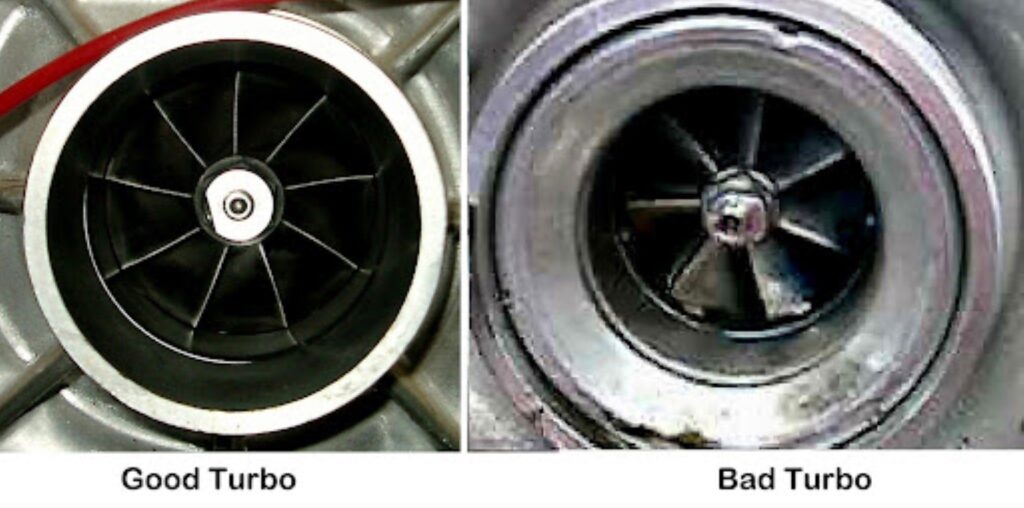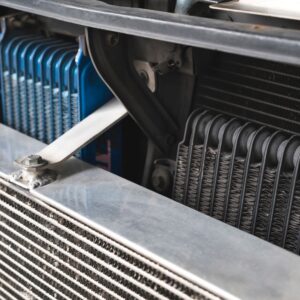Turbochargers or turbos increase the vehicle’s overall efficiency and performance. They use forced induction to drive more air into the cylinders of the engine, boosting horsepower while reducing emission levels and fuel consumption.
Unfortunately, turbos don’t last forever. Turbochargers spin at incredibly high speeds ranging from 50,000 to 150,000 rpm. Over time, they wear out.
It’s important to know how to tell if a vehicle’s turbo is going bad — as well as what you can do to keep it in good condition.
Turbochargers spin at incredibly high speeds ranging from 50,000 to 150,000 rpm. Over time, they wear out.
– Richard McCuistian, ASE Certified Master Automobile Technician
How to Tell if the Turbo is Going Bad
Turbos can leak oil because the bearings receive pressurized lube from the engine’s oil gallery. If the bearings wear out, the shaft wobbles and allows the turbo vanes to touch the housing, which destroys the unit (see photo).

Some warning signs your turbocharger is starting to fail include problems with acceleration, reduced fuel efficiency, and a lit check engine light (this may not happen unless the turbo has failed in a major way). Other symptoms include the lingering smell of burning oil, strange noises, and too much exhaust smoke.
Lit Check Engine Light
A lit check engine light can point to turbocharger issues. While it might indicate a different problem, it still pays to determine what triggered the light. Use an OBD-II code scanner to retrieve the light’s trouble code or take your vehicle to a mechanic for proper diagnosis.
Problems With Power and Acceleration
Another sign your turbo’s going bad is if your engine feels weaker than usual or if your vehicle struggles to accelerate when you drive. The power loss might seem minimal at first, but an inoperative turbocharger can tank your vehicle’s performance.
Reduced Fuel Efficiency
If the turbocharger fails, air won’t be able to pass through the engine as effectively as before. Oil might also get forced into the air inlet and clog the air filter.
These issues not only negatively impact performance, but they also reduce the vehicle’s fuel economy. You’ll wind up spending more money on fuel, as your engine will consume more of it without increasing its output.
Smell of Burning Oil
A bad turbocharger can leak engine oil, typically because of a crack or a damaged seal. Any oil that drips from the turbocharger is burned in the engine, creating an unpleasant odor. It might be hard to see the leaks because oil burns quickly, so be wary of that burning smell.
Strange Noises
If you hear unusual sounds coming from your engine, such as whining, rattling, grinding, and other high-pitched clunky noises, there might be something wrong with the turbo. Inspect the turbocharger as soon as you can before it develops into a more serious problem.
Too Much Exhaust Smoke
When oil from a bad turbo leaks into the exhaust, the exhaust generates significantly more smoke. Normal exhaust smoke is colorless, but the excess exhaust smoke caused by a bad turbo is typically blue.
How Often Do Turbochargers Need to be Replaced?
On average, turbochargers need to be replaced every 100,000 to 150,000 miles. The exact mileage will vary depending on whether the turbocharger is well taken care of. Good driving habits and regular maintenance (among other practices) can also extend a turbocharger’s lifespan.
How to Keep Your Turbocharger in Good Condition
The best ways to keep your turbocharger in good condition include avoiding aggressive driving, giving the engine time to cool, and letting the engine warm up before driving. It’s also important to perform regular maintenance if you want to prolong your turbo.
Avoid Aggressive Driving
Drive safely and steadily to avoid putting unnecessary strain on the turbocharger. It’s a good idea to familiarize yourself with your vehicle’s limits and avoid pushing the turbo beyond them. Being too aggressive with the accelerator is a surefire way to damage the turbo.
Give the Engine Time to Cool
After driving, give your vehicle time to cool down without turning the engine off. Turning off the engine immediately after driving will cause the residual heat to boil any oil in the turbo system. This can corrode and damage the engine, so let the engine run and cool down on its own before turning it off.
Let the Engine Warm Up
Before you put the pedal to the metal, it’s a good practice to let the engine warm up — especially if it’s cold out. Always wait at least 10 minutes before going full throttle when driving a car. This way, the engine can heat up and reach its optimum temperature levels.
Perform Regular Maintenance
The best way to prolong any part of your vehicle is to get regular maintenance. This means bringing your vehicle to an auto shop at least once or twice a year for a mechanic to look at. Experts can accurately diagnose problems with your vehicle and make recommendations. They can also do oil changes and other necessary procedures.
Proper Oil Maintenance
Engine oil lubricates the moving parts of the engine, turbochargers included. Always use good engine oil recommended by your manufacturer if you want to prolong your turbocharger. Similarly, get your oil changed every 5,000 miles for maximum turbo longevity.
Where to Get Turbochargers for Your Vehicle
Shop at CarParts.com today and check out our catalog of high-quality turbochargers.
Whether you prefer shopping on your mobile device or your computer, we’ve made it a point to set up our website so that everything’s one click away. Our built-in vehicle selector makes it easier to check for fitment. All you need to do is enter your vehicle’s specific year, make, and model.
Got questions about our products? Our lines are open 24/7, so our team members can happily assist you with your order.
Order now, and get your new turbochargers in as quick as two business days!
Any information provided on this Website is for informational purposes only and is not intended to replace consultation with a professional mechanic. The accuracy and timeliness of the information may change from the time of publication.

































